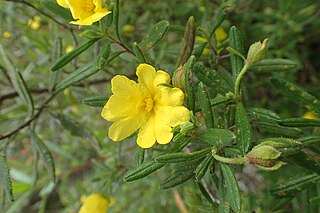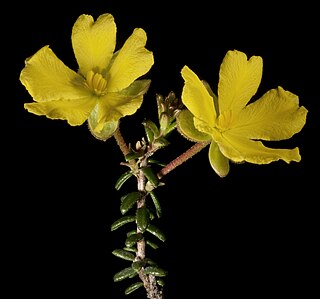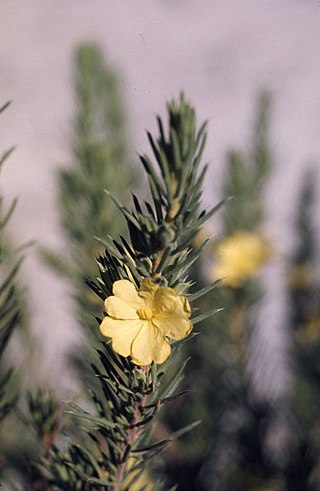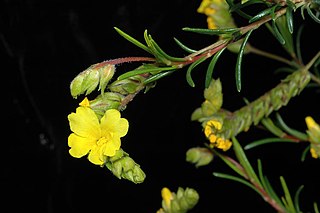
Hibbertia hypericoides, commonly known as yellow buttercups, is a species of flowering plant in the family Dilleniaceae and is endemic to the south-west of Western Australia. It is usually a spreading shrub with linear to elliptic or egg-shaped leaves, and yellow flowers, usually with ten to fifteen stamens arranged in a cluster on one side of the two densely hairy carpels.

Hibbertia vestita, commonly known as hairy guinea-flower, is a species of flowering plant in the family Dilleniaceae and is endemic to eastern Australia. It is a small shrub with foliage covered with simple hairs, usually linear leaves, and yellow flowers with 22 to 43 stamens with many staminodes arranged around three hairy carpels.
Hibbertia banksii is a species of flowering plant in the family Dilleniaceae and is native to Queensland and New Guinea. It is a shrub with thick, leathery leaves and yellow flowers with about twenty to forty-eight stamens arranged on one side of the two carpels.
Hibbertia depilipes is a species of flowering plant in the family Dilleniaceae and is endemic to the far south-west of Western Australia. It is usually a sprawling shrub with scattered linear leaves and yellow flowers arranged singly in leaf axils usually with ten stamens all on one side of the two carpels.

Hibbertia desmophylla is a species of flowering plant in the family Dilleniaceae and is endemic to the south-west of Western Australia. It is a sprawling or erect, hairy shrub with spreading, densely clustered, linear leaves and yellow flowers with eleven to thirteen stamens.

Hibbertia furfuracea is a species of flowering plant in the family Dilleniaceae and is endemic to near-coastal areas of south-western Western Australia. It is an erect shrub with narrow egg-shaped leaves with the narrower end towards the base, and yellow flowers borne in upper leaf axils, with ten to twelve stamens all on one side of two carpels.

Hibbertia glomerosa is a species of flowering plant in the family Dilleniaceae and is endemic to the south-west of Western Australia. It is a shrub with linear to narrow oblong leaves and bright yellow flowers borne on the ends of short side shoots, with twenty-five to thirty-eight stamens arranged in groups of five around the five glabrous carpels.
Hibbertia guttata is a species of flowering plant in the family Dilleniaceae and is endemic to the Northern Territory. It is a straggly shrub with moderately to densely hairy foliage, linear to elliptic leaves, and yellow flowers arranged in leaf axils with 28 to 36 stamens arranged in groups around the three carpels.
Hibbertia lividula is a species of flowering plant in the family Dilleniaceae and is endemic to the south-west of Western Australia. It is an erect or sprawling shrub with thin branchlets, bluish-grey, narrow elliptic to narrow oblong leaves and yellow flowers, with thirty to forty stamens arranged around the five glabrous carpels.
Hibbertia malacophylla is a species of flowering plant in the family Dilleniaceae and is endemic to Queensland. It is a spreading shrub with densely hairy foliage, elliptic leaves, and single yellow flowers arranged in leaf axils with 50 to 55 stamens arranged around the two carpels.
Hibbertia malleolacea is a species of flowering plant in the family Dilleniaceae and is endemic to the northern parts of the Northern Territory. It is a straggly shrub with hairy foliage, elliptic leaves, and yellow flowers arranged in leaf axils with 28 to 32 stamens arranged in bundles around three carpels.
Hibbertia marrawalina is a species of flowering plant in the family Dilleniaceae and is endemic to a restricted part of the Northern Territory. It is a shrublet with scaly foliage, wiry branches, narrow linear leaves, and yellow flowers arranged singly in leaf axils with fifteen to eighteen stamens and about seven staminodes arranged in bundles around two scaly carpels.

Hibbertia microphylla is a species of flowering plant in the family Dilleniaceae and is endemic to the south-west of Western Australia. It is a shrub with weakly ascending stems, broadly egg-shaped to elliptic leaves and yellow flowers, usually with ten stamens and up to nine staminodes arranged on one side of, and leaning over the two densely hairy carpels.

Hibbertia mucronata is a species of flowering plant in the family Dilleniaceae and is endemic to the south of Western Australia. It is an erect shrub with hairy branches, crowded, thick, tapering linear leaves ending in a sharp point, and golden yellow flowers with five stamens fused at their bases, all on one side of two densely hairy carpels.
Hibbertia pilulis is a species of flowering plant in the family Dilleniaceae and is endemic to Arnhem Land in the Northern Territory. It is a straggly shrub with hairy foliage, elliptic leaves and yellow flowers arranged singly in leaf axils with 34 to 46 stamens arranged in bundles around two carpels.
Hibbertia scabra is a species of flowering plant in the family Dilleniaceae and is endemic to the north of the Northern Territory. It is a small shrub with hairy foliage, linear to narrow elliptical leaves and yellow flowers arranged singly near the ends of branches with about fifty stamens arranged around two densely scaly carpels.

Hibbertia spicata is a species of flowering plant in the family Dilleniaceae and is endemic to the west of Western Australia. It is a low, erect to spreading shrub with scattered linear leaves with the edges rolled under and yellow flowers with six or seven stamens on one side of two softly-hairy carpels, and a larger number of staminodes.
Hibbertia ulicifolia is a species of flowering plant in the family Dilleniaceae and is endemic to the south coast of Western Australia. It is a shrub with spirally arranged, linear to awl-shaped leaves and golden yellow flowers with nine stamens fused at the bases, all on one side of two densely shortly-hairy carpels.
Hibbertia velutina is a species of flowering plant in the family Dilleniaceae and is endemic to Queensland. It is a shrub with foliage covered with rosette-like hairs, elliptic leaves, and yellow flowers with thirty to thirty-six stamens arranged in bundles around two densely scaly carpels.
Hibbertia verrucosa is a species of flowering plant in the family Dilleniaceae and is endemic to the south-west of Western Australia. It is a shrub with scattered, densely hairy, narrowly rectangular leaves and yellow flowers usually with ten stamens fused at the bases, all on one side of two densely softly-hairy carpels.








